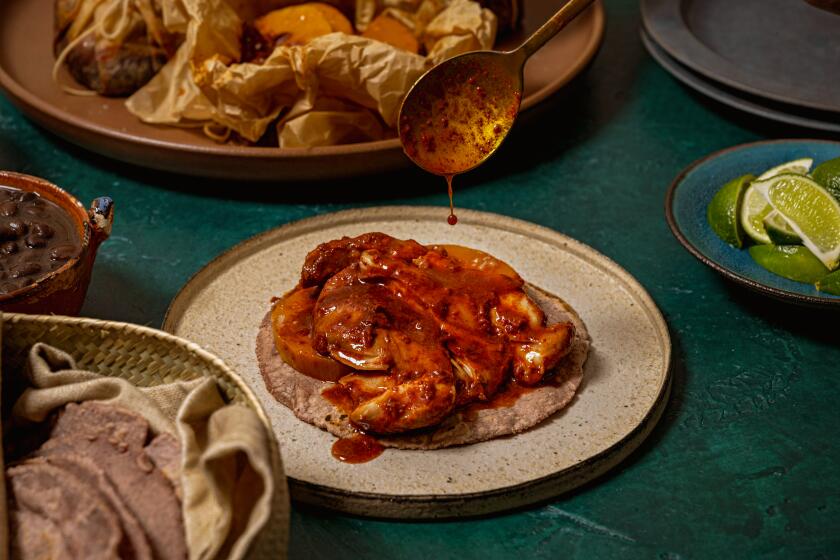Thai red curry duck with pumpkin
- Share via
Three times lately I have had to reassure friends that using canned pumpkin is not a crime against nature -- having seen the fruit go from field to can in a factory in Illinois, I know there is nothing to it but pure puree. But every time I go to a farmers market lately I hear the opposing argument in my head while looking over the gorgeous, fat, pie pumpkins and cheese pumpkins available fresh.
This time of year getting out a can opener really is a shame. The pumpkins glowing orange and taupe in the fall sunlight beg to be turned into anything but a dish where the canned kind would do. Add an Asian accent and the chunky orange flesh can be converted into an amazing entree, or appetizer, or side dish, no crust required.
What’s surprising is that pumpkin and the cuisines of countries associated more with sushi and curry are actually very old friends. Squash, the huge family that includes pumpkin, may have originated in the Americas, but it has traveled farther and wider than even corn. And cooks who use it halfway around the globe do things to it that Libby’s has never put on the label.
In South Korea, for instance, hardly the first country that comes to mind when you mention pumpkin, it is converted into a porridge with red beans that is finished with cinnamon-scented balls of rice. Hi Soo Shin Hepinstall, giving the recipe in her book “Growing Up in a Korean Kitchen,” writes that pumpkin was brought to her homeland by the Dutch in the late 1500s.
It also must have a long history on the Indian subcontinent, because it is absolutely ingrained in the cuisine there, whether stewed in curries or deep-fried as pakora. Japanese cookbooks do not often specify pumpkin, but that country harvests a cornucopia of excellent winter squash that will do as well or better in any recipe, particularly Hokkaido and kabocha.
The many virtues of fresh pumpkin include its ability to cross any geographic or culinary border, to be savory or sweet, dessert or main dish. As well as it works with cinnamon and cloves, it also takes to the assertiveness of Asian fish sauce or garlic-chile paste, and it is as complementary with fresh ginger as with ground. It may be a fruit, but it has vegetable muscle.
Right now two types of pumpkin are readily available, and both work extremely well in savory recipes. Pie pumpkins look like miniature jack-o’-lanterns, round and deep orange, while cheese pumpkins are taupe-colored and heavy and look like butternut squash turned into tuffets. (They are much smaller cousins of the pumpkins that wind up in cans.)
Asian influence
Sliced thin, either pumpkin cooks very fast for tempura. A light batter of egg yolk, rice flour and club soda insulates the meat from the hot oil just long enough for the sturdy flesh to caramelize and turn sweet.
All it needs is a dipping sauce of salty shoyu or tamari, sweet mirin, garlic-chile paste and lots of fresh ginger. You could serve this as an appetizer or add a few more complementary vegetables to the mix (sliced shiitakes, red peppers, broccoli) and make it a main dish.
The only tricks are that the oil has to be perfectly hot (375 degrees -- a candy thermometer is your best friend); the pumpkin has to be dusted in superfine rice flour to make the batter adhere; and the batter itself should be left fairly lumpy.
One of the more fascinating ways to cook pumpkin comes from Vietnam. Nicole Routhier included a braising recipe in her 1989 cookbook “The Foods of Vietnam.” A lavish amount of garlic along with a little sugar and good dose of fish sauce takes pumpkin into another realm of flavor, with sweetness against that haunting undertone from the fish sauce.
As someone who thinks everything goes better with curry, I am happiest turning a pumpkin into a main dish with duck, another favorite ingredient.
Knowing that Thai curries sometimes use pumpkin, I came up with a slow stew with shallots, ginger and coconut milk. Unlike Indian curries, which start with various freshly ground spices, this one is dependent on curry paste. The excellent kind that comes in a can.
In a deep heavy skillet or Dutch oven, heat the oil. Add the garlic, ginger and shallots and saute until softened, about 5 minutes. Stir in the coconut milk and 2 teaspoons of the curry paste. Season the duck legs well with three-fourths teaspoon salt and add to the pan. Bring to a simmer, cover the pan and cook until the duck is very tender, about 45 minutes to 1 hour.
Using a slotted spoon, transfer the duck legs to a plate and let stand until cool enough to handle.
Add the diced pumpkin to the pan and return to a simmer. Cook, covered, until the pumpkin is soft but not mushy, about 45 minutes.
Shred the duck meat into bite-size chunks and return it to the pan. Cook, stirring occasionally, until the meat is heated through. Stir in the lime juice. Taste and add more curry paste or salt if needed. Sprinkle with the basil and serve with rice.
Get our Cooking newsletter
Get a taste of Los Angeles — and the world — with recipes and kitchen tricks from the L.A. Times’ Cooking newsletter.
You may occasionally receive promotional content from the Los Angeles Times.















